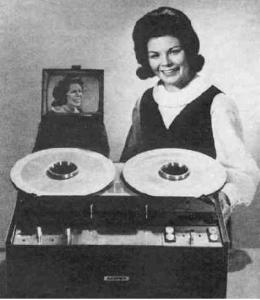Technology's Curious Race Against Itself: Innovation, Preservation, and the Fate of Digital Media

A good friend of mine recently purchased a slick, HD-ready, wall-mountable, LCD panel TV, and as a consequence, I inherited from her a shockingly heavy old tube that will, in all likelihood, be my last CRT television. With the TV, she offered me a stack of forlorn looking VHS cassettes, but I passed on those, explaining that I hadn't owned a VCR in years. Later, I realized that I know exactly one person who maintains a commitment to the old cassette format, and he has long since taken to positioning himself as a sort of renegade VHS archivist dedicated to the preservation of 1970s and '80s B-movies that might never see the light of a digital reissue.
While the rest of us are busy celebrating the vast improvements in sound and image quality realized by the new formats, this lonely partisan of VHS technology is actively concerned with what we've cast aside on the merry march of digital progress. When you think about it, his quest is more than just a quixotic exercise in nostalgia. The man has a legitimate point about the lifecycle of certain media, and his point applies to a wealth of material extending far beyond the forgotten action films of his youth. At today's frenetic pace of both production and development, we run a real risk of losing not only artifacts of the analog era but those of the earliest days of digital as well.
A pair of popular press articles from last week nicely illustrate a tension that exists between innovation and preservation in the world of digital media. In the UK's Guardian, Vanessa Thorpe argues that "the fast pace by which technology changes means that many of the earliest works of art created on computer are in danger of being lost, or are already impossible to read, while new interactive digital artworks, such as 3D visualisations and video games, are so complex that scientists are not yet capable of faithfully preserving them." Meanwhile, a profile of U. Chicago's new Joe and Rika Mansueto Library in the tech mag Wired suggests that a hybrid library system offering new school web resources, streamlined physical collections, and robotic retrieval services strikes a quirky balance that just might be the future of campus-based research.
The Guardian article hinges on the point (previously made here and elsewhere) that in the relentless expansion of the digital, there is a quasi-Schumpterian process of creative destruction in which new technologies build and improve upon their forebears, leaving behind a wake of obsolete programming and discarded formats. Reporter Thorpe writes that the "race is on against the fast pace of technological change as scientists search for ways to preserve today's most innovative artworks," and a novel tension arises here in that technology gets double billing as both problem and solution. The challenge facing those scientist-preservationists is very much a technical quandary that is thought to have a technical fix, and Thorpe argues that the challenge is made all the more daunting by the fact that the intricacy of some new media artifacts is such that the act of preservation is no longer anything so simple as keeping a copy of a unique work intact and safe from degradation. To a real extent, the context--or the means of accessing and viewing that artifact--must now somehow be preserved as well, thus posing problems that are analogous to those presented by installations and performance art but are, if anything, more multifarious.
Angela Watercutter's Wired profile of the Joe and Rika Mansueto Library opens another window onto the complicated world of digital collecting. The University of Chicago's recent entry into the hotly debated "library of the future" field offers some things we have come to expect (an emphasis on web-based research and the general absence of bookshelves) and some that we might not (an Asimov-meets-Borges physical collection housed underground in space-economizing and vertiginous stacks serviced by robotic cranes). As read by Watercutter, the meaning of the library is that digital collections have limitations that are still handily addressed by the incessantly eulogized but remarkably hardy print volumes. Quoting U. Chicago's head librarian, Judith Nadler, Watercutter argues that copyright issues alone are enough to render even the capacious Google Books collection frustratingly incomplete for the foreseeable future.
When read alongside Thorpe's article on the lifecycle of digital media artifacts, it's easy to both appreciate the Mansueto compromise and to imagine a host of further problems presenting themselves along the road to universal digitization. From that standpoint, the physical collection, invulnerable as it is to issues of compatability and interfacing, seems downright enduring. And while the musty old book may yet be destined to go the way of the VHS, my good friend and the authors of these articles would all contend, going digital is still not without its downside.